The Thermo Scientific™ ARL™ EQUINOX 100 X-ray diffractometer (XRD) is suitable for structural and phase investigation in both industrial and research settings. The bench-top design provides a cost-effective alternative for regular analysis, dynamic investigations, formulation determinations, and teaching in universities and colleges.
The ARL EQUINOX 100 XRD contains a curved position-sensitive detector (CPS) that captures entire patterns in real time, allowing for quicker analysis, in situ experiments, and crystalline phase development/phase transitions.
- Standard power source; no need for extra water cooling
- Strong and dependable without any moving components
- High intensity from a microfocus source with little power
- Real-time simultaneous data acquisition
- Adaptable sample entry and analysis
- Improve sample representativeness by measuring transmission and reflection
Reliable and Robust
The Thermo Scientific ARL EQUINOX line is suitable for many laboratories, including mobile, production control, and central labs. This X-Ray diffraction (XRD) technology enables greater flexibility and faster process reaction times.
- No moving parts: stationary X-Ray source and detector
- Fixed focal length: no need for realignment
- Asymmetric mode acquisition across 110˚2θ
- Adaptable angle of incidence for the sample
- Perfect for measurements of small angles
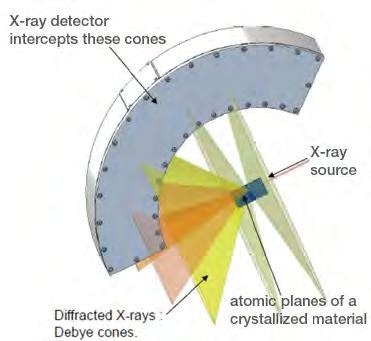
ARL EQUINOX 100 geometry: Asymmetric mode with a Position Sensitive Detector for real-time XRD acquisition. Image Credit: Thermo Fisher Scientific - Elemental and Phase Analysis
Flexible Instrument
High Intensity from Low-Power Microfocus Source
Microfocus X-Ray sources are low-powered X-Ray tubes that produce an extremely bright beam. This setup collects and focuses scattered X-Rays using a mirror system to collect and focus the beam. At low power, the X-Ray flux diffracting the sample is significantly greater than in standard systems.
- X-Ray flux close to a standard X-Ray source
- Focusing mirror for higher intensity
- Mirrors capture and focus X-Rays onto sample for better efficiency.
- Beam size: approximately 5 mm×300 µm
- Focusing beam geometry
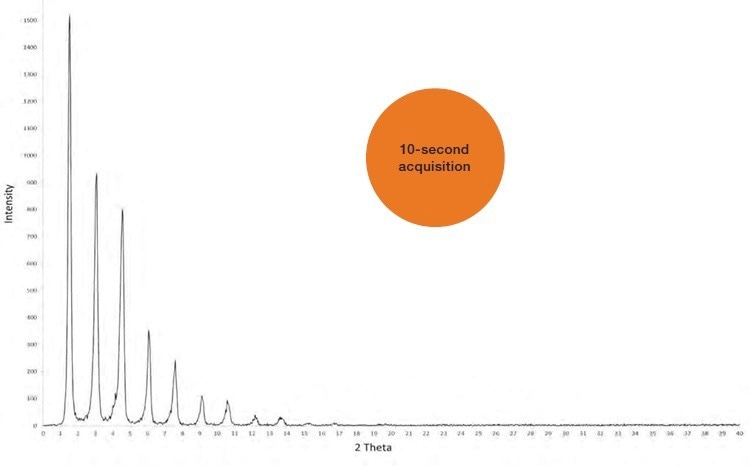
Acquisition at low angle on Silver behenate powder recorded in reflection mode. Image Credit: Thermo Fisher Scientific - Elemental and Phase Analysis
Versatile Sample Entry and Analysis
The ARL EQUINOX 100 XRD is the most flexible benchtop XRD instrument on the market. It can detect reflection or transmission in a variety of sample types and analytical settings. Sample holders can be replaced in seconds and do not require any adjustment. The accessory phases are as follows:
- Single-position spinning stage for reflection and transmission
- Controlled atmosphere reflection sample stage
- Reflection mode spinning stage with height adjustment
- Six-position automatic sample changer with spinning stages
- Fixed non-spinning sample stage
- GIXRD thin layer analysis stage
- Capillary transmission sample stage
- Temperature-controlled stage
Real-Time Simultaneous Data Acquisition
CPS real-time detectors gather diffraction data concurrently, making them a unique acquisition tool. These detectors can conduct diffraction tests on powders, bulk materials, and thin films in real-time, allowing for quick analysis and dynamic research.
Studies and Applications
Dynamic Studies

Phase transition at high temperature. Image Credit: Thermo Fisher Scientific - Elemental and Phase Analysis
Dynamic crystallographic measurements in real time are necessary for the study of the physical and chemical characteristics of materials as a function of temperature, environment, pressure, and other factors. Position Sensitive Detectors (PSD) allow for the real-time recording of structural phase transitions or material alterations.
It can be particularly difficult to ensure that no transition is missed during a measurement when working with unstable substances. However, the PSD obtains the whole XRD diffractogram simultaneously.
Thin Film Applications
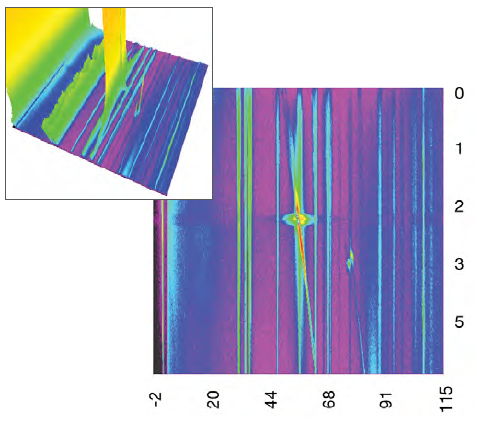
Grazing incidence measurement: Observation of an interference with the substrate peak. Image Credit: Thermo Fisher Scientific - Elemental and Phase Analysis
The ARL EQUINOX 100 XRD has a customized sample platform that makes it simple and accurate to analyze thin film materials.
Grazing incidence XRD (GIXRD) detects the phases, texture, and structure of a thin crystallized deposit on a substrate, whereas XRR measures the thickness and roughness of film deposits and interfaces.
Samples and Attachments
Fixed Sample Stage

Image Credit: Thermo Fisher Scientific - Elemental and Phase Analysis
- Stationary sample mount for powders, solids, or samples on a glass plate
- Sample position aligned by positioning screw
- Reflection or transmission mode
Spinning Stage for Powder Sample

Image Credit: Thermo Fisher Scientific - Elemental and Phase Analysis
- Reflection and transmission mode on powder
- Zero background holder for micro-quantity samples
- Continuous sample rotation
- Special cups to protect air-sensitive samples
Spinning Stage with Height Adjustment
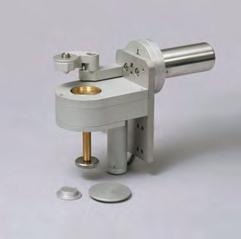
Image Credit: Thermo Fisher Scientific - Elemental and Phase Analysis
- Reflection mode on powder and bulk
- Height adjustment to 30 mm
- Sample maximum size: 40×20 mm with a centered sample
- Continuous sample rotation
Spinning Stage for FilterStudies
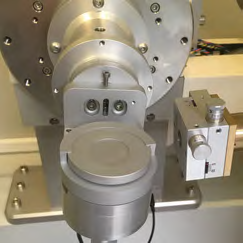
Image Credit: Thermo Fisher Scientific - Elemental and Phase Analysis
- Specific measurement in reflection mode on filter
- Available with silver membrane filter (25 mm diameter)
- Continuous sample rotation
Spinning Stage for Pressed Pellets

Image Credit: Thermo Fisher Scientific - Elemental and Phase Analysis
- Reflection mode for pressed samples like cement
- Continuous sample rotation
- Choice according to customer’s specifications
- 51 mm steel rings
- 40 mm steel rings or free pressed
Sample Stage with Controlled Atmosphere
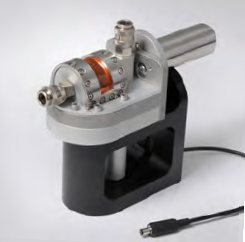
Image Credit: Thermo Fisher Scientific - Elemental and Phase Analysis
- Continuous sample rotation
- Reflection mode for powder
- Modes of operation
- Fully isolated cell with closed connections
- Gas control in the cell
- Gas circulation to recycle atmosphere
Capillary Stage for Transmission Measurement

Image Credit: Thermo Fisher Scientific - Elemental and Phase Analysis
- Transmission mode on sample in capillary
- Goniometric head support
- Borosilicate or quartz capillaries available with a diameter from 0.1 to 3.5 mm
- Continuous sample rotation
Automatic 6-Position Sample Changer
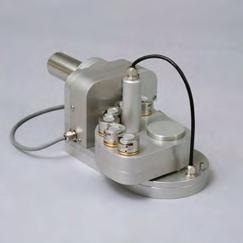
Image Credit: Thermo Fisher Scientific - Elemental and Phase Analysis
- Zero background holder available
- Six sample positions in reflection mode
- Continuous sample rotation
Thin Layer Attachment

Image Credit: Thermo Fisher Scientific - Elemental and Phase Analysis
- High accuracy motors in θ and Z adjustments
- Specific attachment for thin film application
- X-Ray reflectometry (XRR)
- Excellent for GIXRD
- Sample size up to 25×25×10 mm
Temperature Controlled Stage

Image Credit: Thermo Fisher Scientific - Elemental and Phase Analysis
- BTS500: temperature range from ambient to 500 °C
- BTS150: temperature range from –10 °C to 150 °C
- Sample conditioning in vacuum, air, or inert gas possible
- Reflection mode
- Fast heating and cooling
- 10–1 mbar to 1 bar relative
- Accurate temperature measurements by a thermos sensor close to the sample
Analytical Performance
The ARL EQUINOX 100 XRD can be employed to quickly and precisely analyze a range of materials, from minerals to pharmaceuticals. Since the entire pattern is acquired simultaneously, the instrument has extraordinary resolution and speed for a benchtop device. The ARL EQUINOX 100 XRD can be used for phase identification, quantitative estimations of percentage crystallinity, and even the solution of crystal structures.
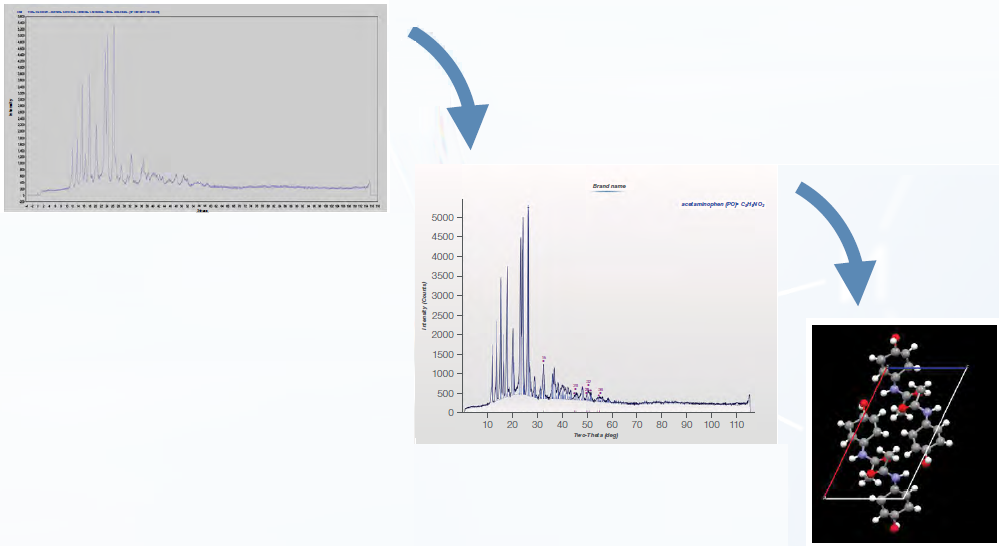
Image Credit: Thermo Fisher Scientific - Elemental and Phase Analysis
Thermo Scientific™ SolstiX™ XRD Software 21 CFR Part 11 Ready

Image Credit: Thermo Fisher Scientific - Elemental and Phase Analysis
Thermo Scientific SolstiX XRD Software with Security Suite is compatible with the ARL EQUINOX 100 X-Ray benchtop diffractometer, allowing pharmaceutical businesses to produce compliance results without compromising performance. The software solutions meet 21 CFR Part 11 standards for electronic signatures and comprehensive audit trails.
- Safeguard electronic data connected to quality assurance on manufacturer computer systems
- Establish safeguards to ensure that records are reliable, legitimate, and incorruptible
- Electronic signatures enable users to bear responsibility for their electronic data in the system
- Set requirements in the data record: date and time of the scan, the name of the signer, and technological controls to guarantee safety (for example, passwords)